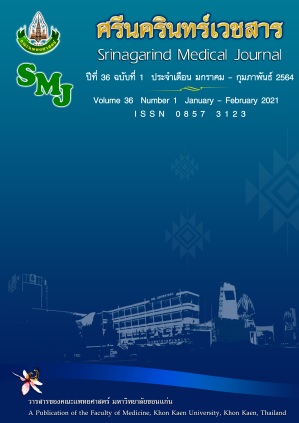Antihypertensive and Antioxidative Effects of Asiatic Acid in Rats with Long-Term Exposure to Cadmium
Keywords:
Asiatic acid; Cadmium; Hypertension; Nitric oxide; Oxidative stressAbstract
Background and objective: Cadmium (Cd) is a toxic heavy metal which causes oxidative damage to various tissues and associated with hypertension. Antioxidants have been used to protect against Cd intoxication. Asiatic acid (AA) is a pentacyclic triterpenoid extracted from Bua-Bok (Centella asiatica) and possesses strong antioxidant activities. This study aimed to investigate whether AA could attenuate hypertension and oxidative stress in rats chronically exposed to Cd.
Methods: Male Sprague-Dawley rats were exposed to Cd daily via consumption of water containing 10 ppm cadmium chloride for 16 weeks. Rats in the control groups received deionized water as drinking water. AA (15 or 30 mg/kg b.w.) was orally administered once daily for the last 4 weeks of the experiment.
Results: Cd induced hypertension in rats by increasing arterial blood pressure and peripheral vascular resistance. Cd significantly attenuated the vasodilating responses to acetylcholine (p < 0.05) while the vasodilating responses to sodium nitroprusside were unchanged. AA in a dose dependent manner significantly improved hemodynamics and increased endothelial-dependent responses (p < 0.05). AA alleviated oxidative stress, enhanced blood glutathione and increased plasma nitrate/nitrite level. Moreover, AA also reduced the accumulation of Cd in blood and vascular tissues.
Conclusions: These results suggest that AA is a protective antioxidant against Cd-induced hypertension, endothelial dysfunction and oxidative stress.
References
2. Satarug S, Garrett SH, Sens MA, Sens DA. Cadmium, environmental exposure, and health outcomes. Environ Health Perspect 2010; 118(2): 182-190.
3. Godt J, Scheidig F, Grosse-Siestrup C, Esche V, Brandenburg P, Reich A, et al. The toxicity of cadmium and resulting hazards for human health. J Occup Med Toxicol 2006; 1: 22.
4. Houston MC. The role of mercury and cadmium heavy metals in vascular disease, hypertension, coronary heart disease, and myocardial infarction. Altern Ther Health Med 2007; 13(2): S128-133.
5. Prozialeck WC, Edwards JR, Nebert DW, Woods JM, Barchowsky A, Atchison WD. The vascular system as a target of metal toxicity. Toxicol Sci 2008; 102(2): 207-218.
6. Messner B, Bernhard D. Cadmium and cardiovascular diseases: cell biology, pathophysiology, and epidemiological relevance. Biometals 2010; 23(5): 811-822.
7. Loganathan C, Thayumanavan P. Asiatic acid prevents the quinolinic acid-induced oxidative stress and cognitive impairment. Metab Brain Dis 2018; 33(1): 151-159.
8. Maneesai P, Bunbupha S, Kukongviriyapan U, Senggunprai L, Kukongviriyapan V, Prachaney P, et al. Effect of asiatic acid on the Ang II-AT1R-NADPH oxidase-NF-kappaB pathway in renovascular hypertensive rats. Naunyn Schmiedebergs Arch Pharmacol 2017; 390(10): 1073-1083.
9. Bunbupha S, Pakdeechote P, Kukongviriyapan U, Prachaney P, Kukongviriyapan V. Asiatic acid reduces blood pressure by enhancing nitric oxide bioavailability with modulation of eNOS and p47phox expression in L-NAME-induced hypertensive rats. Phytother Res 2014; 28(10): 1506-1512.
10. Nakmareong S, Kukongviriyapan U, Pakdeechote P, Donpunha W, Kukongviriyapan V, Kongyingyoes B, et al. Antioxidant and vascular protective effects of curcumin and tetrahydrocurcumin in rats with L-NAME-induced hypertension. Naunyn Schmiedebergs Arch Pharmacol 2011; 383(5): 519-529.
11. Sangartit W, Kukongviriyapan U, Donpunha W, Pakdeechote P, Kukongviriyapan V, Surawattanawan P, et al. Tetrahydrocurcumin protects against cadmium-induced hypertension, raised arterial stiffness and vascular remodeling in mice. PLoS One 2014; 9(12): e114908.
12. Donpunha W, Kukongviriyapan U, Sompamit K, Pakdeechote P, Kukongviriyapan V, Pannangpetch P. Protective effect of ascorbic acid on cadmium-induced hypertension and vascular dysfunction in mice. Biometals 2011; 24(1): 105-115.
13. Skoczynska A, Martynowicz H. The impact of subchronic cadmium poisoning on the vascular effect of nitric oxide in rats. Hum Exp Toxicol 2005; 24(7): 353-361.
14. Yoopan N, Watcharasit P, Wongsawatkul O, Piyachaturawat P, Satayavivad J. Attenuation of eNOS expression in cadmium-induced hypertensive rats. Toxicol Lett 2008;176(2): 157-161.
15. Alissa EM, Ferns GA. Heavy metal poisoning and cardiovascular disease. J Toxicol 2011; 2011: 870125.
16. Moskovitz J, Yim MB, Chock PB. Free radicals and disease. Arch Biochem Biophys 2002; 397(2): 354-359.
17. Dorta DJ, Leite S, DeMarco KC, Prado IM, Rodrigues T, Mingatto FE, et al. A proposed sequence of events for cadmium-induced mitochondrial impairment. J Inorg Biochem 2003; 97(3): 251-257.




